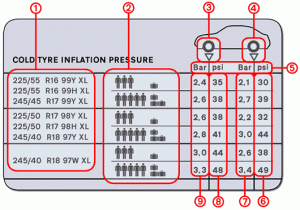Using the correct tyre pressure is important as the incorrect pressure – whether under or over inflated will cause uneven tyre wear, vehicle instability issues and under inflation will increase fuel consumption.
Tyre pressures vary depending on the tyre type and the weight in which they support. The most accurate way to determine the correct pressure for your specific vehicle is to read the tyre pressure sticker on your vehicle.
Most vehicles place the sticker on the ‘B’ pillar or ‘post’. This is the centre pillar of your vehicle, where the sticker is located on the inside, drivers side, where the door and pillar meet when closed.
Other tyre pressure label locations may be on the under-surface of the bonnet, or on the inside of the fuel filler cap. Failing that, if you cannot find a sticker, consult your car owners manual. If you don’t have one, they are often available in PDF format from the manufacturers website. If all else fails, give a dealer a call.
Tyre Pressure Sticker Explained
On initial glance, the tyre pressure sticker can look like a bunch of numbers, little pictures and confusing abbreviations. The tyre pressure sticker image corresponds with the explanation below.

- Select your tyre from the list. These numbers and letters make up the size and width (among other things) of your tyres. Look around the outer side wall of one of your tyres. You will see numbers formatted similar to those on the label diagram. Use a pen and paper to write down your tyre type. Most cars have the same front and rear tyres, though in some cases they may be different. Check both and front tyre to ensure they’re the same. If they are different, write down both types.
- Compare your tyres to those on the sticker. Keep within the thick separating lines and move along to the symbols of people and luggage. Select the top section if your vehicle is light – up to three people in the car with light luggage, or the option under if you have a car full of passengers with a boot full of luggage.
- This option is for the front tyres along with the corresponding list of numbers below.
- This option is for the rear tyres along with the corresponding list of numbers below.
- Bar and PSI are both units of pressure. If you are using a tyre pump on a petrol station forecourt as most drivers do, you will need to select either Bar or PSI pressure unit on the pump – it doesn’t matter which unit you use as long as the tyre pump supports it.
- For the rear tyre, if you are using PSI, use the amount of pressure on the list that has your tyre type (within the thick lines) and follow the option along the lighter or heavier load.
- For the rear tyre, if you are using BAR, use the amount of pressure on the list that has your tyre type (within the thick lines) and follow the option along the lighter or heavier load.
- For the front tyre, if you are using PSI, use the amount of pressure on the list that has your tyre type (within the thick lines) and follow the option along for either the lighter or heavier load.
- For the front tyre, if you are using BAR, use the amount of pressure on the list that has your tyre type (within the thick lines) and follow the option along for either the lighter or heavier load.
Tyre pressure stickers do vary slightly depending on the vehicle manufacturer, but they generally all follow a similar format.
When Should I check Tyre Pressures?
- Ideally, check tyre pressures every two weeks
- Check pressures at the start of a journey when your tyres are cold
- Always check tyre pressures before a long journey
